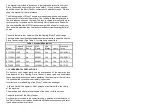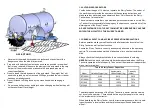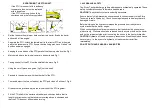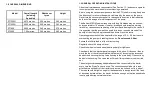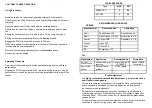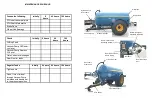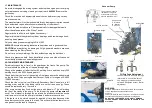
2.0 WHEEL CHANGING PROCEDURE
It is
compulsory
to employ a professional tyre fitter to carry out any
wheel changing maintenance. The tyre fitter must follow these
instructions carefully.
The slurry tanker must be connected securely to the tractor with
wheels chocked to minimise movement before wheel changing pro-
cesses can begin.
The slurry tanker must be emptied before any wheel changing
maintenance can begin. The tanker can be emptied into another va-
cant slurry tanker by means of one fill pipe with 2 identical connection
ends. Each end of the fill pipe can be connected to the fill points of the
2 separate tankers. When emptying the tanker, it is important to suck
into the empty tanker rather than blow from the full tanker.
When changing a wheel, always position the tanker on a hard, level
surface and if carrying out the procedure on a public highway,
consider the gradient of the
camber
before jacking or propping.
Jacking mechanism should have an extension of approximately
400mm to allow enough clearance for tyre to come off and to be put
on again when fully inflated. It is also highly recommended to use an
air actuated jack so that the tyre fitter can stand well clear of the slurry
tanker while Jacking.
Consult with your professional tyre fitter to determine if the tyre can be
fixed without removing it from the slurry tanker.
If the wheel must be removed, ensure that an axle stand prop is
appropriately positioned before the wheel is removed.
DO NOT PROP WITH DECAYED, UNEVEN TIMBER OR CEMENT
BLOCKS. Use appropriate timber as shown below.
Never enter the danger zone when the wheel is removed.
Jacking points must be
checked at regular intervals
and if damaged contact your
local dealer immediately.
SLURRY GASES CAN KILL.
Vacate slatted houses of animals and people
when mixing is in progress. Do not stand near tank openings or stoop to floor
level when mixing. Secure suction hoses to prevent them from falling into the
tank. Do not enter a below ground level tank. If unavoidable attach a lifeline
held by two persons.
SLURRY GASES CAN BE FLAMMABLE
. Never allow naked flames near the
tanker or tank openings.
NEVER
open the rear door to enter the tanker without first decompressing the
tanker and venting all gases. If entering the tanker always have another person
standing by.
Before attempting to clear any blockages in the spread plate, ensure the pump
lever is in neutral, the tank is depressurised and the rear discharge valve is
closed.
NEVER DISTRACT PERSONS WHO ARE USING THIS MACHINE.
1.4 PTO SHAFT LENGTH
The PTO shaft length may be altered to suit individual tractors. During opera-
tion when the PTO is at its maximum extended length there must be a mini-
mum overlap of 1/3 PTO shaft length as shown in the minimum PTO overlap
diagram.
The Slurry Tanker should be hitched to the tractor and be checked in various
positions to ensure that the PTO drive line is the correct length. Remember
that undulating ground can also affect the length of the PTO shaft.


